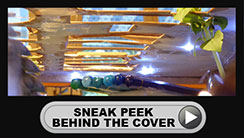
Paul Foley is a local Brit who has been living in Switzerland for about 12 years. Like many others, he came here for a short stay and then forgot about the word short. Having had children he soon realized that chocolate probably wasn’t the healthiest food for them so in an attempt to improve their diet (and learn a bit more French) Paul took up bee keeping via one of the local associations.
Four years later, he finds sitting in the forest with the bees gently buzzing on the wind is actually a beautiful way to spend an hour or two (although he's not mad enough to do it without protective clothing!) He now produces his own organic honey, using bee hives that are “housed” in a nature reserve in Chavannes-de-Bogis. The bees’ food source is a combination of forest, pasture and “biological agricultural” – this means that the farmers who grow crops near the hives are growing bio products, so there is nothing that needs masses of chemicals adding to it. He does not feed the bees during honey production, he does not add chemicals to the hives during honey production (or before), and he does not move the bees. All the honey is processed by hand within 3km of the hive location.
 Paul explains why this is all so important. “In Switzerland the rules for keeping bees are quite strict. The bees are considered as livestock by the state, therefore any bee hives must be registered and periodically inspected. During the honey producing periods of the year we are not permitted to feed the bees (if you do, you’ll end up with a jar of yellow sugar!) The chemicals that may be used in the hive are specified by the state Bee Research Center and Veterinary Service - and there are times in the year that they still cannot be used. Under no circumstances am I allowed to add antibiotics to the hive (in other countries this is common place)”
Paul explains why this is all so important. “In Switzerland the rules for keeping bees are quite strict. The bees are considered as livestock by the state, therefore any bee hives must be registered and periodically inspected. During the honey producing periods of the year we are not permitted to feed the bees (if you do, you’ll end up with a jar of yellow sugar!) The chemicals that may be used in the hive are specified by the state Bee Research Center and Veterinary Service - and there are times in the year that they still cannot be used. Under no circumstances am I allowed to add antibiotics to the hive (in other countries this is common place)”
So popular is the organic honey that Paul produces that his annual tours during harvest time are already fully booked this year. So if you want to sample his honey, you will have to head on down to the local epicerie in Chavannes-de-Bogis, buy it online at MyExpatShop, or drive over to Jim's British Market in St. Genis Pouilly, France.
If you’re wondering whether it’s worth all that effort when you can buy a cheap jar of honey from your local supermarket, Paul describes in simple terms why it’s better to buy 'local',
“When you buy local honey you are effectively buying something that contains a lot of the 'stuff' that your body will use to generate defense mechanisms against items that are found in your local area. If you eat honey created by bees from the other side of the planet, that's great if you want to spend time there but wont really help your defense mechanisms here.”
He goes on to describe in his own words one of the little known skills possessed by beekeepers: Forecasting. Read on, and when you’ve finished don’t forget to take a look at Paul’s website and answer the two questions at the end of his article to win yourself a jar from each of his harvests!
Forecasting for Bee Keepers, by Paul Foley
 I don’t know about you but I always love watching the weather report; the guy gets up in front of the map, the computer makes wavy lines move around behind him and he proclaims with an amazing degree of certainty ‘Its going to be a hot, sunny day – break out the sun cream!’.
I don’t know about you but I always love watching the weather report; the guy gets up in front of the map, the computer makes wavy lines move around behind him and he proclaims with an amazing degree of certainty ‘Its going to be a hot, sunny day – break out the sun cream!’.
Invariably the next day starts with a few minutes of sun, the clouds come over and then the sun tan cream gets to prove if it’s water proof or not.
The weatherman then gets up the following night and, behaving as if nothing has gone wrong, proclaims that tomorrow might be rainy.
It would appear that making predictions is comparable to gambling – one wonders if perhaps there is anything relating to the weather that we could predict with a degree of certainty.
Off the top of my head I can think of one or two things that I can say with certainty in relation to the weather:
1. If it’s raining there’s not going to be any honey
2. If it’s too cold there’s not going to be any honey
I now feel like an old man sitting on the porch dispensing ‘wisdom’ to the young people who are polite enough to listen.
But what about positive predictions?
Well, I can predict honey color and taste.
One of the things that most people are surprised by when they first see honey is that it comes in many different colors (although truth be known I’ve never seen blue or green) and that each bee keeper produces honey that has a slightly different taste and color.
Now you’d assume that bees are all the same, they’re all in the same country and the process of manufacture is identical – so what are the bee keepers doing to make it different?

Simply put, nothing, the bees are doing it all by themselves.
I mentioned that I can predict the color of the honey that my bees are making, it’s not actually witchcraft it’s simply a matter of looking at what they’re eating and when.
Allow me to explain.
In the spring the bees are flying around looking for food at a time when the first of the commercial crops is almost ready. So, whilst they wait, they eat the little flowers in the forest (in the spring this is primarily Primrose for my bees) and after a certain amount of time they move on to the rape seed (Colza) flowers.
If they eat mostly primrose then I already know that the honey will be very pale when I harvest it, it will taste really sweet and will crystalize within a couple of weeks (and then be chalk white). If they eat primarily rape seed then the honey will be yellow, be sweet (but not as sweet as primrose) and take about a month to crystalize. This honey will be harvested at the end of May (as late as the first week of June if the weather is bad).
The second harvest is taken at the end of June. At this point in time the commercial crops have either flowered and finished or have not flowered yet (depending upon the crop). This means that the bees will be ‘picnicking’ in the forest.
This again tells us in advance what the color and taste will be. It will be a nice dark brown color (comparable to maple syrup in color). The taste will be sweet but given that it has a higher mineral content it will not be as sweet as the spring honey. This harvest takes place at the end of June and the honey will take a few months to crystalize.
Finally the third harvest takes place at the end of July and is based (for my bees) on the sunflowers and clover. The sunflowers give it a smooth, light brown color whilst the clover provides a certain sweet taste. This honey will take a month or two to crystalize and once it has done so its initial texture is comparable to a fine fudge (although it doesn’t taste like fudge).
So there you go, you can now impress your friends at that next company picnic by telling them what the honey will be like without even looking inside the hive and you now know that when you look around the supermarket and see nothing but pure yellow honey that is always liquid then something is probably ‘not quite right’.

 Now that you know all about “Forecasting for beekeepers”, take a look at Paul’s website (www.1279honey.com) to help you answer the following questions, and win yourself a jar of honey from each of his harvests.
Now that you know all about “Forecasting for beekeepers”, take a look at Paul’s website (www.1279honey.com) to help you answer the following questions, and win yourself a jar of honey from each of his harvests.
1. What does the 1279 in 1279honey.com stand for?
2. What’s the name of the little girl inspecting the bee hives (in the gallery section)?
Send your answers by email by 31 July 2011 using the contact form on Paul’s website and he’ll choose two winners at the beginning of August.
Paul Foley
Organic Beekeeper
Chavannes-de-Bogis
EDITOR'S NOTE: The winner of the competition was Marcella from Lausanne - well done!






